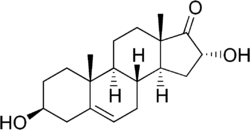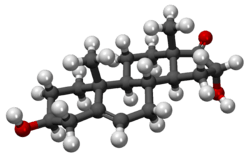16α-Hydroxy-DHEA
16α-Hydroxydehydroepiandrosterone (16α-hydroxy-DHEA or 16α-OH-DHEA) is an endogenous metabolite of dehydroepiandrosterone (DHEA). Both 16α-OH-DHEA and its 3β-sulfate ester, 16α-OH-DHEA-S, are intermediates in the biosynthesis of estriol from dehydroepiandrosterone (DHEA).[1] 16α-OH-DHEA has estrogenic activity.[2]
 | |
 | |
| Names | |
|---|---|
| IUPAC name
(3S,8R,9S,10R,13S,14S,16R)-3,16-Dihydroxy-10,13-dimethyl-1,2,3,4,7,8,9,11,12,14,15,16-dodecahydrocyclopenta[a]phenanthren-17-one | |
| Other names
3β,16α-Dihydroxyandrost-5-en-17-one | |
| Identifiers | |
3D model (JSmol) |
|
| ChEBI | |
| ChemSpider | |
PubChem CID |
|
CompTox Dashboard (EPA) |
|
| |
| |
| Properties | |
| C19H28O3 | |
| Molar mass | 304.42 g/mol |
Except where otherwise noted, data are given for materials in their standard state (at 25 °C [77 °F], 100 kPa). | |
| Infobox references | |
References
- Raju U, Bradlow HL, Levitz M (1990). "Estriol-3-sulfate in human breast cyst fluid. Concentrations, possible origin, and physiologic implications". Ann. N. Y. Acad. Sci. 586: 83–7. doi:10.1111/j.1749-6632.1990.tb17793.x. PMID 2141460.
- Miller KK, Al-Rayyan N, Ivanova MM, Mattingly KA, Ripp SL, Klinge CM, Prough RA (2013). "DHEA metabolites activate estrogen receptors alpha and beta". Steroids. 78 (1): 15–25. doi:10.1016/j.steroids.2012.10.002. PMC 3529809. PMID 23123738.
This article is issued from Wikipedia. The text is licensed under Creative Commons - Attribution - Sharealike. Additional terms may apply for the media files.